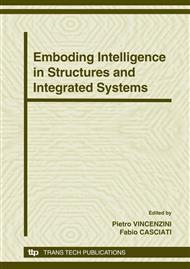p.265
p.271
p.277
p.287
p.297
p.303
p.309
p.315
p.324
Chemical Monitoring of Composite Matrices Using Evanescent Wave Spectroscopy
Abstract:
The results of an initial investigation into the monitoring of water absorption and chemical degradation in epoxy matrix composites using evanescent wave spectroscopy are presented. While conventional silica glasses have too low a refractive index and too short an IR transmission window to be useful as unclad sensing elements in most resin systems, chalcogenide glasses offer suitable refractive indices and infrared transmission windows. Arsenic selenide compositions with gallium or tellurium additions were initially investigated as they have been successfully demonstrated in other fibre sensing applications. However their glass transition point lies near or below the curing temperature for many commercial epoxy resins and thus germanium-antimony-lead sulphide glasses were also investigated as they display higher glass transition temperatures. The fibres were embedded in a representative matrix resin by casting samples of epoxy resin around sections of fibre. The end faces were prepared to allow an infrared beam to be passed along the fibre and the samples were subjected to hygrothermal aging. Changes in the transmitted spectra were observed, and photoelasticity was used to monitor the occurrence of fibre fragmentation. Both the arsenic selenide based compositions and the germanium-antimony-lead sulphide compositions displayed minimal bonding with the epoxy resin, so a simple silane treatment was used to improve adhesion.
Info:
Periodical:
Pages:
297-302
Citation:
Online since:
September 2008
Authors:
Keywords:
Price:
Сopyright:
© 2008 Trans Tech Publications Ltd. All Rights Reserved
Share:
Citation:


